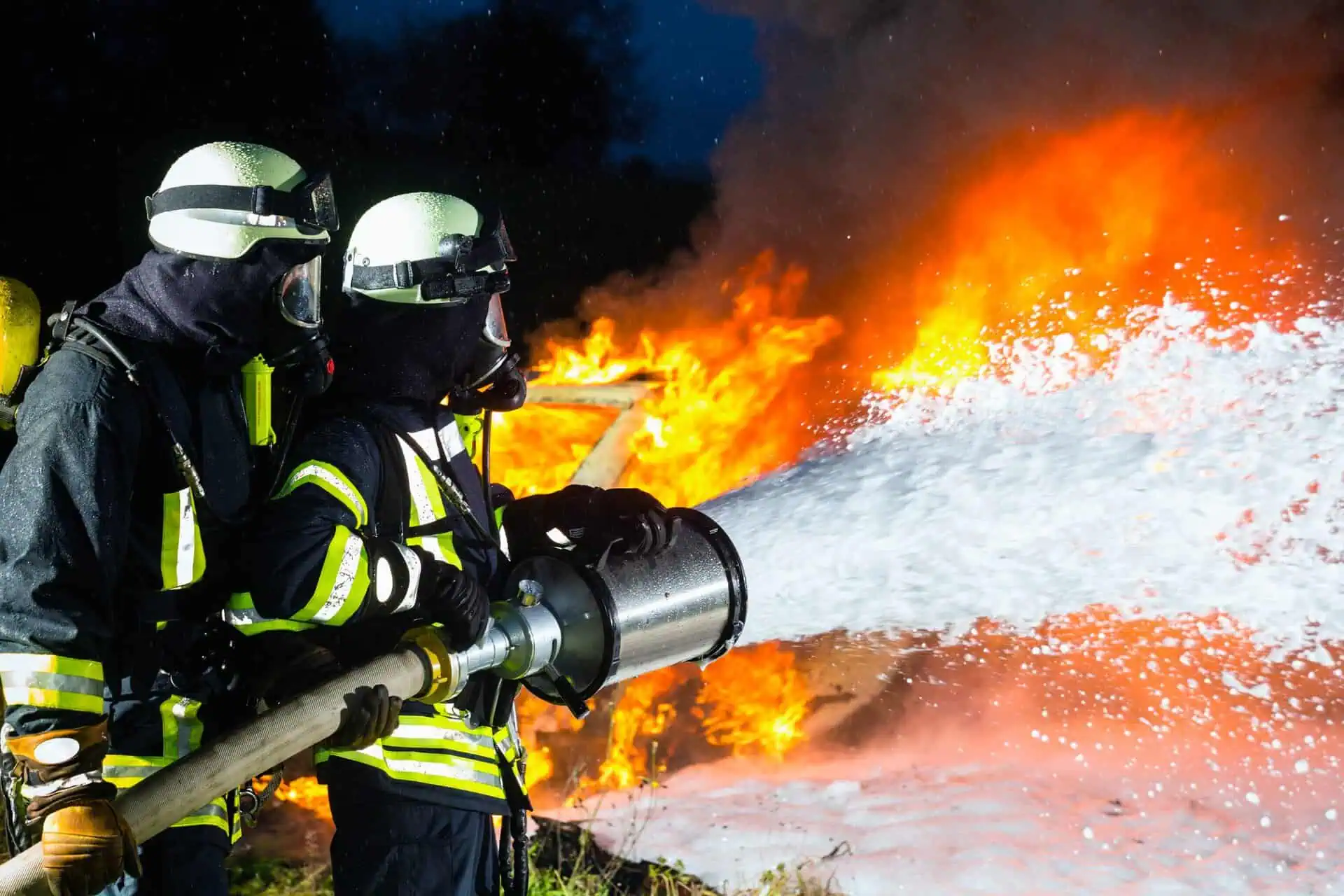AFFF Firefighting Foam Lawsuit and Firefighters’ Health Issues
- Last Updated: June 12th, 2025

Attorney Jessica Paluch-Hoerman, founder of TruLaw, has over 28 years of experience as a personal injury and mass tort attorney, and previously worked as an international tax attorney at Deloitte. Jessie collaborates with attorneys nationwide — enabling her to share reliable, up-to-date legal information with our readers.
Legally Reviewed
This article has been written and reviewed for legal accuracy and clarity by the team of writers and legal experts at TruLaw and is as accurate as possible. This content should not be taken as legal advice from an attorney. If you would like to learn more about our owner and experienced injury lawyer, Jessie Paluch, you can do so here.
Fact-Checked
TruLaw does everything possible to make sure the information in this article is up to date and accurate. If you need specific legal advice about your case, contact us by using the chat on the bottom of this page. This article should not be taken as advice from an attorney.
Key takeaways:
- Firefighters are facing health risks from exposure to firefighting foam, specifically Aqueous Film Forming Foam (AFFF), which has been linked to an increased risk of cancer.
- Lawsuits against manufacturers of AFFF are on the rise as firefighters seek compensation for their health issues caused by exposure to toxic chemicals in the foam.
- Legal action is being taken to hold manufacturers accountable for failing to warn about the potential health risks associated with AFFF and to ensure protection and justice for firefighters affected by foam exposure.
AFFF Firefighting Foam Lawsuit and Firefighters' Health Issues
On this page, we’ll provide an overview of the AFFF Firefighting Foam Lawsuit, firefighters health issues from AFFF Firefighting Foam, how to file an AFFF Firefighting Foam Lawsuit, and much more
Intro To The AFFF Firefighting Foam Lawsuit
The AFFF Firefighting Foam Lawsuit addresses serious health concerns stemming from the use of Aqueous Film-Forming Foam (AFFF) in firefighting and training exercises.
This legal action primarily targets manufacturers for their role in producing and distributing AFFF-containing hazardous chemicals.
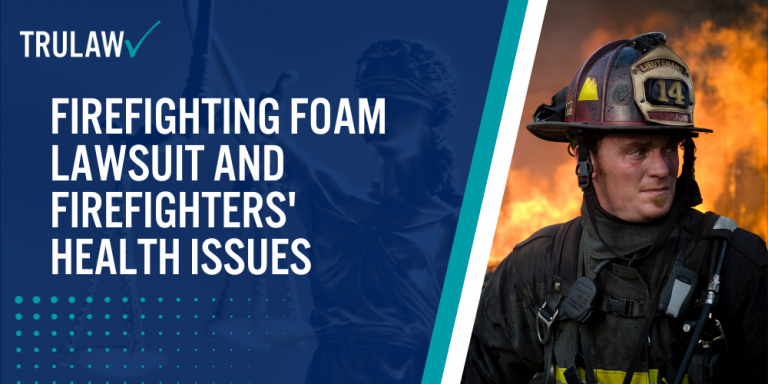
Plaintiffs in the lawsuit include firefighters and other individuals exposed to these chemicals, alleging increased risks of cancer and other serious health conditions.
The litigation seeks accountability and compensation for the harm caused by long-term exposure to the toxic substances found in AFFF.
Table of Contents
AFFF Lawsuit Landscape of Firefighter Health Risks
Numerous public servicemen and women are now battling threatening cancers and diseases after using AFFF firefighting foam products.
The harmful chemicals were laden with carcinogenic elements that refuse to break down in nature or within our bodies.
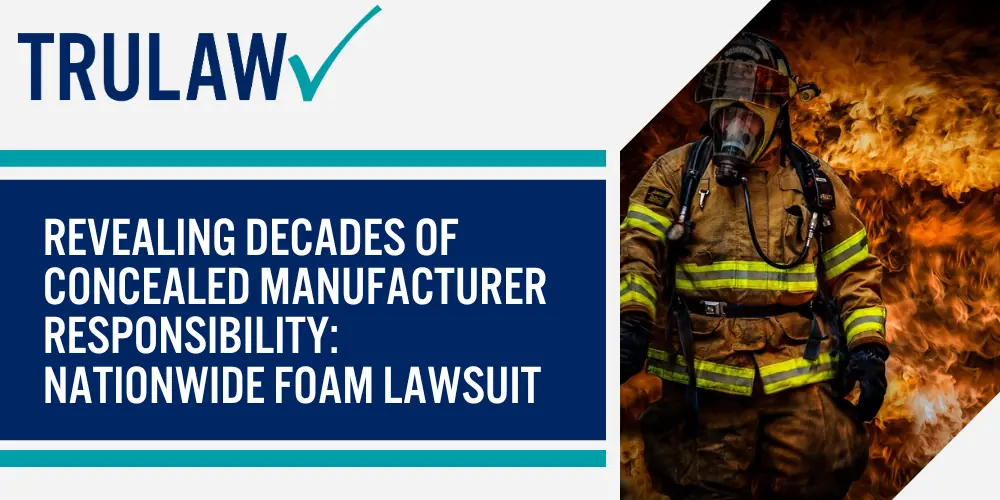
The AFFF lawsuit landscape challenges manufacturers’ claims about product safety while raising awareness about such escalating health impacts among first responders.
As molecular evidence mounts against PFAS contamination from fire suppressants, firefighters and law firms are joining forces to file an AFFF litigation for compensation.
Firefighter wellness is paramount when dealing with hazardous substances like those found in the bunker gear used by these professionals during fire emergencies.
These protective suits degrade under heat conditions yielding traces of PFAS causing potential harm when ingested involuntarily by the wearer.
Understanding the AFFF Lawsuit Landscape: Firefighter Health Risks
Firefighters face significant health risks from toxic chemicals in AFFF, a firefighting foam.
This spongy substance is full of PFAS, harmful substances that increase the risk of diseases like thyroid disease and several types of cancer.
With growing awareness of these dangers, Firefighting foam lawsuit against AFFF manufacturers is on the rise.
Affected individuals and communities are demanding compensation for their suffering caused by this poison exposure.
These behind-the-scenes legal battles highlight the tragic toll toxins take on our brave firefighters’ health.
The ongoing settlement talks paint a vivid picture of what’s at stake in such suits.
Potential settlements could provide some relief to affected parties but won’t reverse their ill-health effects or lost lives due to prolonged exposure.
Manufacturers have been using these dangerous substances for decades, raising troubling questions about long-term impacts— questions now addressed through increased legal actions against those companies responsible for creating AFFF with such hazardous components as PFASs.
Navigating Firefighting Foam Lawsuit for Firefighter Health Protection
Navigating AFFF lawsuits involves several crucial steps to protect firefighter health concerns
- Begin by hiring experienced AFFF firefighting foam lawyers who understand the case-specific scenarios.
- Stay updated on AFFF lawsuit updates, especially when settlement talks are ongoing.
- Gather all relevant medical documents stating exposure to toxic firefighting foam and its resultant health impacts.
- Prepare a strong lawsuit citing manufacturers of AFFF firefighting foam for failing to warn about potential health risks associated with the product’s chemicals.
- Highlight any diagnosis of kidney cancer or similar issues as scientific studies suggest PFAS – a chemical in firefighting foam, is a likely human carcinogen.
- Be ready for prolonged legal battles as negotiations for potential settlement payouts continue.
Firefighting Foam Cancer Exposure Health Implications
Firefighting foam exposure has serious health implications, particularly when it comes to cancer.
Studies have linked the chemicals found in AFFF firefighting foam, such as PFAS to an increased risk of developing various types of cancer.
This is especially concerning for military firefighters who are exposed to these foams regularly.
The cancers associated with AFFF exposure include those affecting firefighters specifically.
It is crucial that legal considerations surrounding the health effects of foam exposure are taken into account and that measures are put in place to protect the well-being of those at risk.
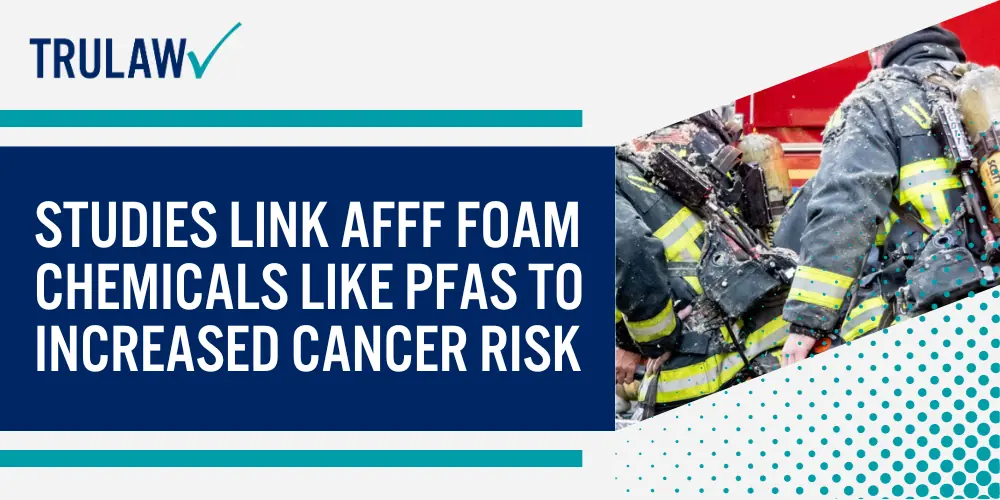
Legal Considerations Surrounding Health Effects of AFFF Firefighting Foam Exposure
AFFF Firefighting foam exposure has raised serious legal considerations surrounding the health effects it can have on firefighters.
The use of Aqueous Film Forming Foam (AFFF) in firefighting has been associated with adverse health outcomes and an increased risk of cancer.
This has led to a rise in lawsuits being filed across the country by those who have been exposed to firefighting foam and subsequently diagnosed with serious health issues, such as various types of cancer.
The toxic chemicals found in AFFF pose significant risks, making it crucial for legal experts to navigate the complex landscape of the firefighting foam lawsuit and advocate for the protection and rights of firefighters affected by foam exposure.
Foam Exposure and Health: Legal Insights and Implications
Firefighters who have been exposed to firefighting foam may face legal challenges related to their health.
The legal system provides insights into the implications of foam exposure on health and offers avenues for seeking recourse.
Firefighters diagnosed with serious health conditions linked to PFAS exposure from firefighting foam can explore legal options for compensation and justice.
The presence of PFAS substances in the foam has been associated with water contamination and various types of cancer, including thyroid disease, testicular cancer, kidney cancer, and bladder cancer.
Understanding the legal aspects surrounding foam exposure is crucial for firefighters seeking justice and accountability for their health issues.
AFFF Lawsuit Legal Insights to Chemicals and Their Impact
Chemicals in AFFF have significant legal implications for those affected by their health impact.
The chemicals found in AFFF have been linked to various types of cancer, including prostate and testicular cancer.
As a result, thousands of lawsuits have been filed against AFFF manufacturers, seeking compensation for the victims’ medical conditions.
These lawsuits aim to hold the manufacturers accountable for their role in exposing individuals to these harmful chemicals.
Successful legal actions may result in cash settlements or verdicts paid to the victims or their families.
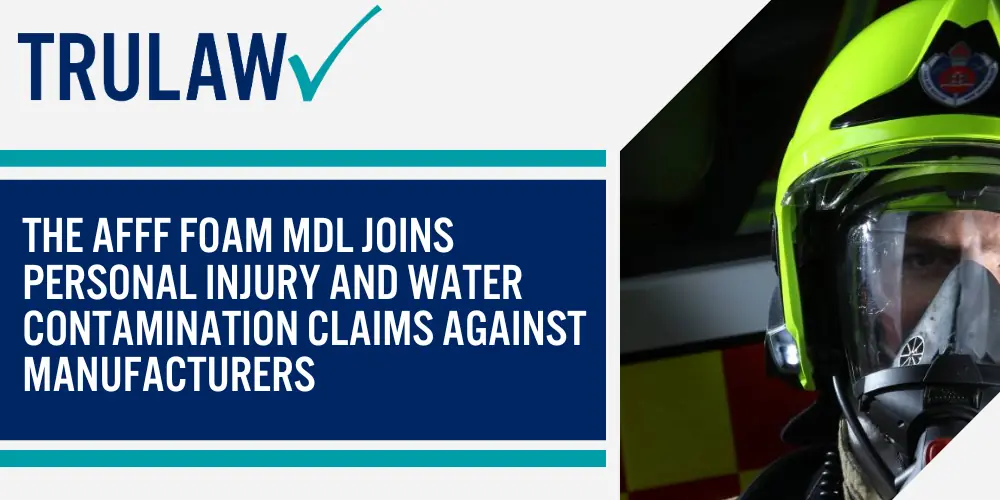
The ongoing AFFF Firefighting Foam MDL consolidates personal injury claims and water contamination cases against the manufacturers, highlighting the profound impact of these chemicals on both individuals and communities.
Legal Perspective on AFFF Chemicals and Their Health Impact
AFFF chemicals and their impact on health are viewed from a legal perspective.
These toxic substances found in firefighting foam have been linked to serious health consequences, including an increased risk of cancer.
From a legal standpoint, individuals who have been exposed to AFFF chemicals and are experiencing health issues have the right to pursue legal action.
The Environmental Protection Agency (EPA) has recognized the immediate concerns surrounding PFAS chemicals, emphasizing their impact on public health.
This legal perspective allows individuals affected by AFFF exposure to seek compensation for their suffering and hold responsible parties accountable for the harm caused by these hazardous chemicals.
Understanding the Legal Ramifications of AFFF Chemicals on Health
AFFF chemicals used in firefighting foam have serious legal implications for health.
Studies have shown that certain PFAS substances present in AFFF are linked to an increased risk of cancer, including prostate and testicular cancer.
Firefighters who have been exposed to these chemicals are taking legal action against manufacturers and gear companies, alleging that they were not adequately warned about the health risks associated with AFFF.
The International Association of Firefighters has highlighted the breakdown of PFAS chemicals in bunker gear as a major concern.
AFFF Lawsuits and Health Consequences and the Cancer Cases
AFFF lawsuits are being filed across the country due to the health consequences and cancer cases associated with firefighting foam exposure.
Firefighters, in particular, are at a higher risk of developing certain types of cancer as a result of their exposure to AFFF.
Recent scientific studies have shown that PFAS chemicals found in the foam are likely human carcinogens and have been linked to kidney, testicular, prostate, and other types of cancer.
The International Association of Fire Fighters has taken legal action against manufacturers for causing increased cancer rates among firefighters.
Consolidation of these AFFF lawsuits is underway in federal court for more efficient proceedings.
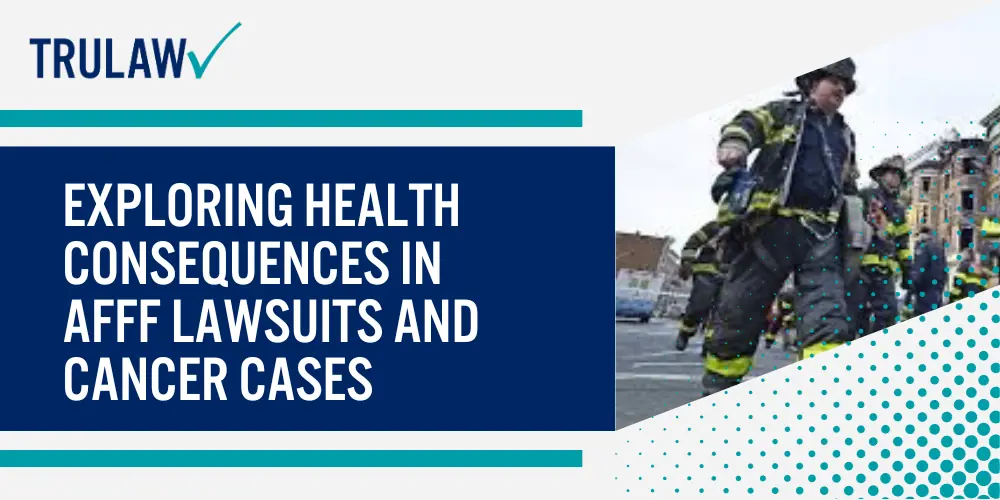
Cancer Cases and AFFF Lawsuits: Health Consequences Explored
Chemical exposure from AFFF has led to a surge in cancer cases, prompting firefighters and affected individuals to take legal action.
The chemicals present in AFFF have been linked to various types of cancer, including prostate and testicular cancer.
As a result, lawsuits are being pursued by those seeking compensation for their health consequences after exposure to AFFF.
With this rising trend, it is clear that the health implications of AFFF are being taken seriously as individuals fight for justice and accountability.
Health Impacts of AFFF-Related Cancer Cases: Legal Aspects
AFFF-related cancer cases have significant health impacts, and understanding the legal aspects is crucial in seeking justice.
Firefighters exposed to AFFF face an increased risk of developing cancer due to the toxic chemicals present in the foam.
The link between AFFF and various types of cancer has been established through scientific studies.
As a result, there are ongoing lawsuits highlighting the legal ramifications and seeking compensation for the health consequences caused by AFFF exposure.
The firefighting foam lawsuit aims to hold responsible parties accountable for their actions and ensure that firefighters receive proper support and resources for their cancer cases.
Firefighting Foam Exposure and Respiratory Health Challenges
Long-term exposure to AFFF firefighting foam can pose significant respiratory health challenges for firefighters.
The foam, known as Aqueous Film Forming Foam (AFFF), contains toxic chemicals that can be inhaled during firefighting operations.
These chemicals have been linked to respiratory issues and may increase the risk of developing lung diseases.
Firefighters exposed to AFFF may experience symptoms such as coughing, wheezing, shortness of breath, and chest tightness.
It is crucial for firefighters to understand the potential health risks associated with foam exposure and take necessary precautions to protect their respiratory health.
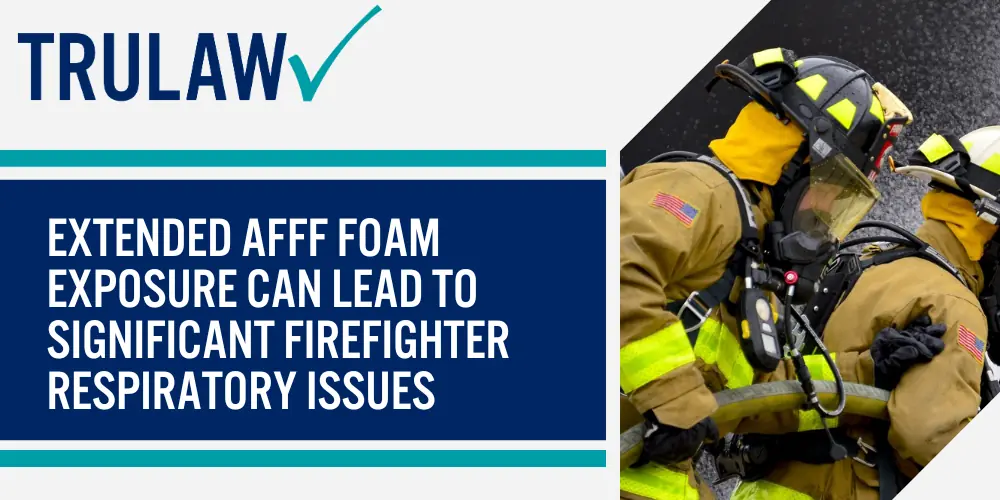
Legal Ramifications of Respiratory Health Challenges Due to Foam Exposure
Exposure to firefighting foam, particularly AFFF, has been linked to respiratory health challenges among firefighters.
This raises significant legal ramifications related to their well-being.
Studies have shown a connection between exposure to PFAS chemicals in AFFF foam and respiratory issues such as lung inflammation and asthma.
Firefighters affected by these health challenges may seek legal recourse and compensation for their condition, highlighting the need for legal protection and support within the firefighting community.
Ultimately, understanding the legal implications of respiratory health challenges due to foam exposure is crucial in ensuring that firefighters receive the necessary care and justice they deserve.
Foam Exposure and Respiratory Health: Legal Insights
Firefighters who have been exposed to firefighting foam may face respiratory health challenges.
There are legal insights into the implications of foam exposure on respiratory health.
Studies have shown that long-term exposure to PFAS chemicals in firefighting foam can lead to serious health effects, including respiratory issues.
Firefighters who have developed respiratory problems as a result of foam exposure can seek legal recourse for their health issues.
By filing lawsuits, they may be able to hold responsible parties accountable and potentially receive compensation for their damages.
PFAS Contamination and Firefighter Health: Lawsuits and Outcomes
Firefighters who have been exposed to PFAS-containing firefighting foam are taking legal action to hold manufacturers accountable for the health consequences.
These lawsuits aim to secure compensation and justice for the firefighters who developed various types of cancer, including kidney cancer, as a result of PFAS exposure.
Recently, an AFFF class-action lawsuit against Johnson Controls resulted in a $17.5 million settlement, highlighting the seriousness of these cases.
The outcomes of these lawsuits will not only provide financial support for affected firefighters but also bring attention to the dangers of PFAS contamination in firefighting foam and advocate for stricter regulations to protect firefighter health.
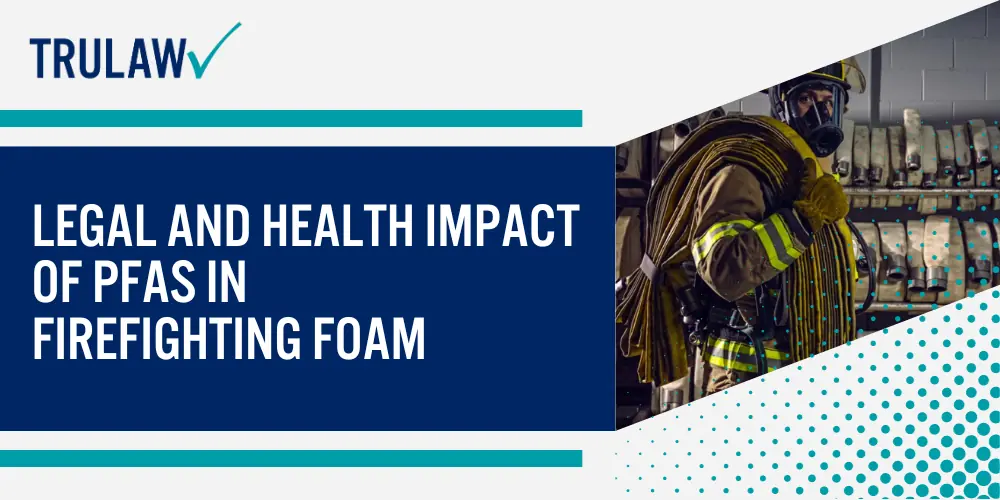
PFAS Contamination in Firefighting Foam: Legal Actions and Health Outcomes
PFAS contamination in firefighting foam has resulted in legal actions and significant health outcomes for firefighters.
Scientific studies have linked PFAS chemicals found in the foam to an increased risk of cancer, including kidney, testicular, and prostate cancers.
As a result, lawsuits have been filed against companies responsible for manufacturing and distributing the foam.
Johnson Controls recently settled a class action lawsuit for $17.5 million due to their PFAS-containing foam.
The presence of PFAS in firefighting foam has also led to contamination of municipal water supplies, potentially causing adverse health effects on humans.
These legal actions seek compensation and justice for firefighters who have suffered from exposure to PFAS-contaminated firefighting foam.
Legal Consequences of PFAS Exposure in Firefighter Health
Plaintiffs in Firefighting Foam lawsuit related to firefighting foam exposure are seeking legal recourse for the health consequences of PFAS exposure in firefighter health.
The use of firefighting foam containing synthetic chemicals (PFAS) has been linked to various types of cancer, including bladder and breast cancer.
Firefighters who used this foam have reported serious health issues due to PFAS exposure.
These lawsuits aim to hold responsible parties accountable for contaminating water supplies and causing adverse health effects in firefighters exposed to AFFF.
AFFF Lawsuit Legal Battles for Firefighters' Health Navigating the Process
AFFF lawsuit legal battles are underway to protect the health of firefighters and help them navigate the legal process.
With concerns about the health effects of firefighting foam, lawsuits have been filed alleging that exposure to AFFF has led to various types of cancer and other health issues.
Johnson Controls, the manufacturer of Tyco Fire Products, recently settled an AFFF class action lawsuit for $17.5 million.
As more plaintiffs join the litigation, the number of AFFF lawsuits is expected to increase.
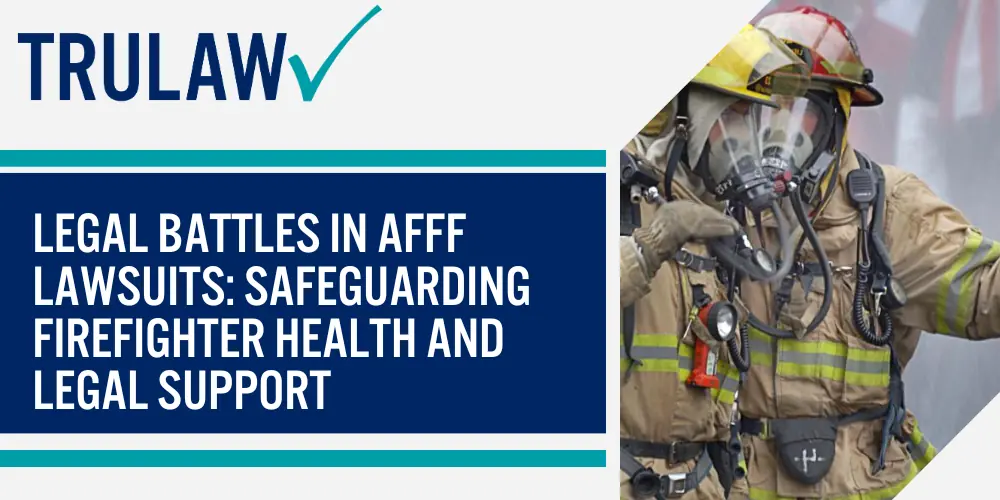
These legal battles aim to hold accountable those responsible for producing and distributing AFFF while providing compensation and justice for firefighters suffering from serious medical conditions linked to foam exposure.
Navigating the complex legal process can be challenging for firefighters seeking recourse for their health issues caused by AFFF exposure.
However, with ongoing lawsuits and settlements being reached, there are options available for those affected.
Firefighters involved in these lawsuits should consult experienced attorneys who specialize in firefighting foam litigation to guide them through each step of the process effectively.
By understanding their rights and legal strategies, firefighters can pursue a fair resolution that provides compensation and support for their wellness impacts resulting from exposure to this potentially harmful substance.
Navigating Legal Battles for Firefighters’ Health in Foam-Related Lawsuits
Firefighters facing foam-related lawsuits have important legal battles ahead as they seek justice for their health issues.
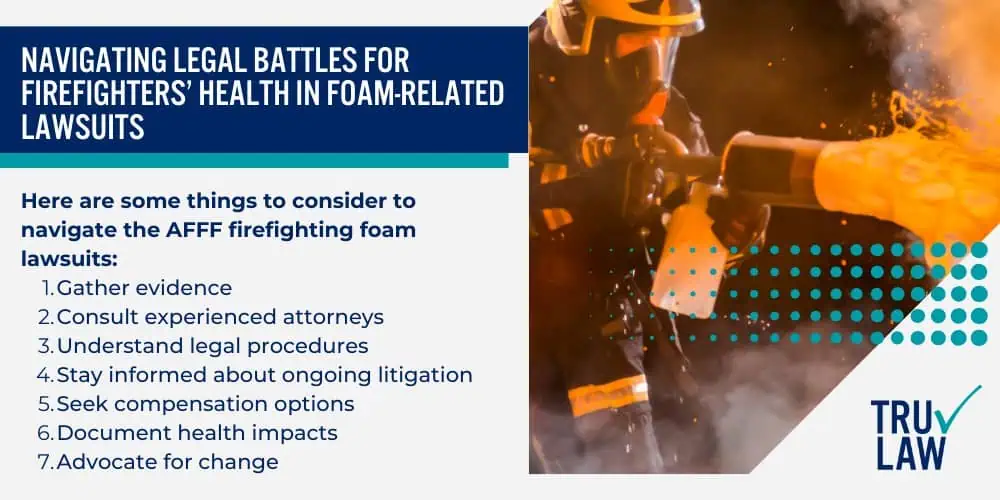
Here are some things to consider to navigate the AFFF firefighting foam lawsuits:
- Gather evidence: Firefighters should collect all relevant medical records and documentation of exposure to firefighting foam chemicals.
- Consult experienced attorneys: It is crucial for firefighters to seek legal representation from lawyers who specialize in handling foam-related lawsuits.
- Understand legal procedures: Firefighters need to familiarize themselves with the legal procedures involved in filing a lawsuit.
- Stay informed about ongoing litigation: Keeping up-to-date with developments in existing AFFF lawsuits can provide valuable insights and strategies for firefighters’ own cases.
- Seek compensation options: Firefighters should explore all available options for compensation related to their health issues caused by foam exposure.
- Document health impacts: It is important for firefighters to maintain detailed records of their health conditions as they progress throughout the lawsuit.
- Advocate for change: While navigating legal battles, firefighters can also contribute to broader efforts aimed at raising awareness about the health risks associated with firefighting foam chemicals and advocating for stricter regulations on its use.
Legal Strategies and Processes in Foam-Related Lawsuits for Health Protection
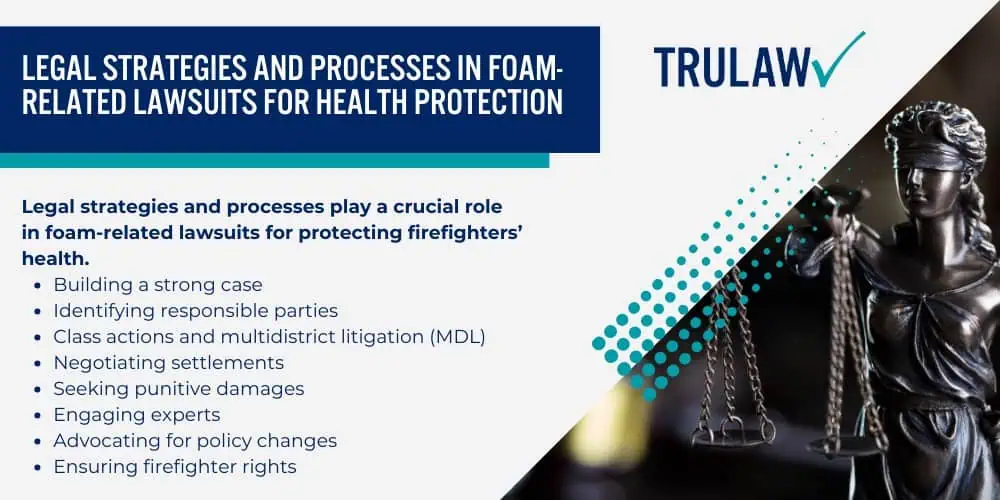
Legal strategies and processes play a crucial role in foam-related lawsuits for protecting firefighters’ health.
- Building a strong case: Attorneys gather evidence, including scientific studies, medical records, and expert testimonies, to establish the link between firefighting foam exposure and health issues.
- Identifying responsible parties: Lawsuits target manufacturers of AFFF foam, such as 3M and DuPont, holding them accountable for the production and distribution of potentially harmful products.
- Class actions and multidistrict litigation (MDL): Consolidating similar lawsuits into class actions or MDL cases allows for efficient handling and streamlining of legal proceedings while maximizing resources.
- Negotiating settlements: Attorneys negotiate with defendants to reach fair settlement agreements that provide compensation for medical expenses, lost wages, pain and suffering, and other damages caused by foam exposure.
- Seeking punitive damages: In some cases, plaintiffs may seek punitive damages to punish manufacturers for their negligence or misconduct related to the production or marketing of firefighting foam.
- Engaging experts: AFFF Lawyers often collaborate with experts in fields like toxicology, environmental science, and occupational health to bolster their case with credible scientific evidence.
- Advocating for policy changes: Beyond individual lawsuits, attorneys may work towards broader impact by advocating for regulatory changes that better protect firefighters from the effects of firefighting foam exposure.
- Ensuring firefighter rights: Legal strategies prioritize protecting firefighters’ rights by seeking compensation for healthcare costs, disability benefits, future monitoring programs, and establishing national firefighter registries to track long-term health outcomes.
Firefighter Lawsuit Wellness and Compensation in Foam-Related Cases
Firefighters who have been affected by exposure to firefighting foam chemicals are seeking wellness and compensation through lawsuits.
These brave first responders are taking legal action against AFFF manufacturers and firefighter gear manufacturers for the health problems they have faced.
One notable case involved Johnson Controls, the maker of Tyco Fire Products, which settled a class action lawsuit for $17.5 million related to AFFF containing PFAS.
The plaintiffs argue that manufacturers failed to adequately warn about the health risks associated with their foam products.
With a settlement in the AFFF lawsuit expected in 2023, firefighters continue fighting for their rights and seeking justice for the impacts on their well-being caused by foam exposure.
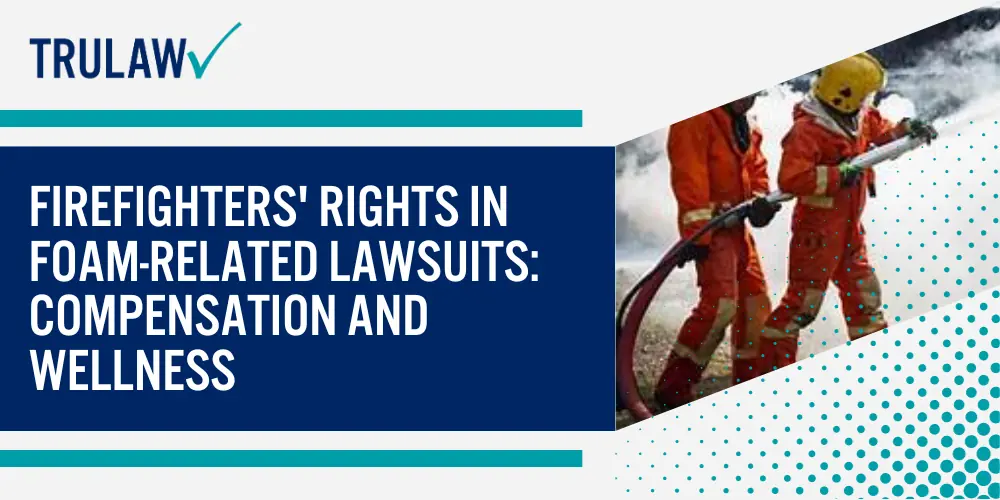
Compensation and Wellness: Firefighters’ Rights in Foam-Related Lawsuits
Firefighters who have experienced health issues due to exposure to firefighting foam have the right to seek compensation and ensure their wellness.
Lawsuits have been filed against manufacturers of firefighting foam for failing to inform the public about potential health risks.
These lawsuits aim to secure financial compensation for firefighters with certain cancers, who may be eligible for compensation through foam-related legal battles.
Additionally, Navy veterans exposed to firefighting foam have also filed lawsuits for adverse effects.
It is crucial that firefighters understand their rights and navigate the legal process to protect their health and secure the compensation they deserve.
Legal Pathways to Secure Compensation for Firefighter Wellness Impacts
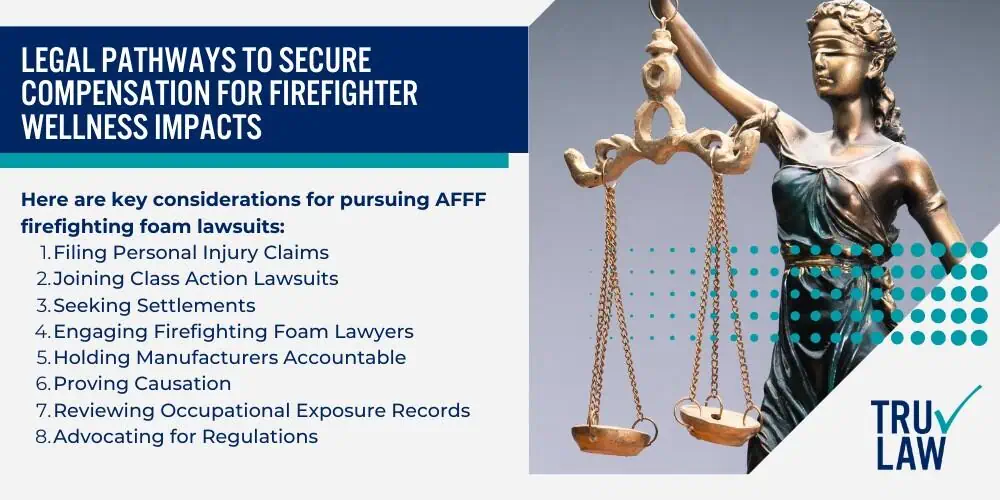
Here are key considerations for pursuing AFFF firefighting foam lawsuits:
- Filing Personal Injury Claims: Firefighters can pursue personal injury claims against manufacturers and distributors of AFFF foam for the harm caused by their products.
- Joining Class Action Lawsuits: Firefighters may join class action lawsuits, which allow multiple individuals with similar claims to seek compensation collectively.
- Seeking Settlements: Negotiating settlements with the companies responsible for manufacturing and distributing AFFF foam is another potential avenue for securing compensation.
- Engaging Firefighting Foam Lawyers: Working with experienced firefighters’ foam lawyers can provide guidance, support, and representation throughout the legal process.
- Holding Manufacturers Accountable: Legal actions are being taken to hold manufacturers accountable for producing and selling AFFF foam containing harmful PFAS chemicals.
- Proving Causation: Firefighters will need to provide evidence linking their health issues directly to exposure to AFFF foam in order to establish causation and strengthen their claims.
- Reviewing Occupational Exposure Records: Gathering and reviewing occupational exposure records can help demonstrate a connection between firefighting duties, foam usage, and subsequent health problems.
- Advocating for Regulations: In addition to seeking compensation, firefighters can also advocate for stronger regulations on the use of AFFF firefighting foam to prevent future health risks.
AFFF Foam Lawsuit Securing Legal Recourse for Firefighters
Firefighters who have been exposed to AFFF foam chemicals and are suffering from health issues now have the option to seek legal recourse through AFFF foam lawsuits.
These lawsuits aim to hold manufacturers accountable for their role in producing and distributing foam products containing harmful PFAS chemicals.
Manufacturers like 3M and DuPont have already been named in these lawsuits, which are being filed nationwide by firefighters seeking compensation for their medical expenses, lost wages, and pain and suffering.
Through these legal actions, firefighters hope to secure the justice they deserve while raising awareness about the health risks associated with firefighting foam exposure.
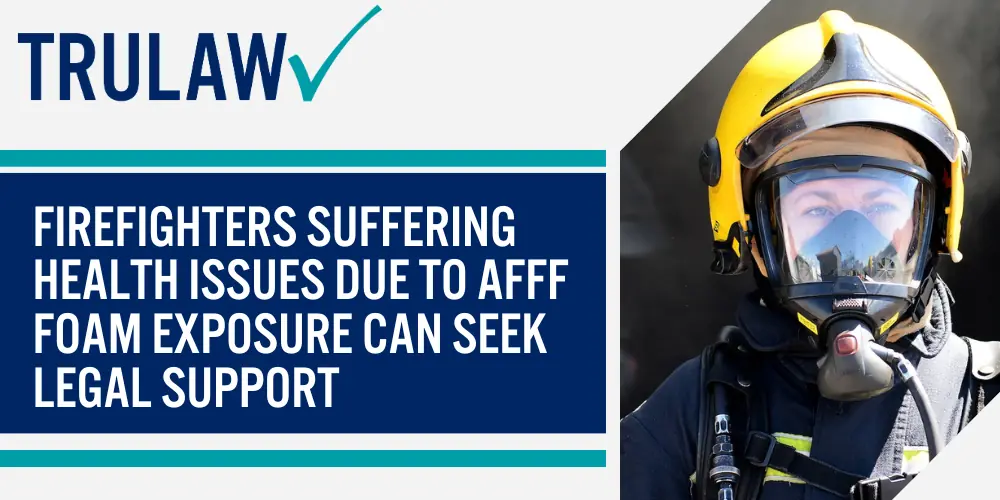
Firefighters who have developed health problems as a result of AFFF foam exposure can now turn to the legal system for support.
Lawsuits against manufacturers such as 3M and Dupont aim to provide firefighters with the opportunity to seek compensation for their illnesses.
By taking legal action, these brave individuals hope not only to receive financial restitution but also raise public awareness about the dangers of AFFF foam chemicals.
It is crucial that firefighters affected by this issue understand that there are options available for them through these lawsuits – they do not need to face these challenges alone.
Legal Recourse and Compensation for Firefighters with Health Issues from Foam Exposure
Firefighters who have experienced health issues due to exposure to firefighting foam can take legal action and seek compensation.
Many firefighters have already filed lawsuits against the manufacturers of PFAS chemicals and firefighter gear, claiming that their exposure to the foam has caused or increased the risk of health problems.
These lawsuits argue that the manufacturers failed to provide sufficient warning about the potential risks associated with their products.
Settlement negotiations are currently underway in these cases, and valid claims from prior mass tort cases similar to the AFFF lawsuit indicate that settlements could potentially range between $20,000 and $600,000 (or more).
By filing a firefighting foam lawsuit, firefighters can pursue legal recourse and potentially secure compensation for their health issues resulting from foam exposure.
Firefighter Health Problems and Legal Strategies for Recourse
Firefighters exposed to PFAS-based firefighting foam face serious health problems, including bladder cancer, breast cancer, leukemia, liver cancer, and lymphoma.
The buildup of PFAS in the foam also increases the risk of thyroid disease and cancers of the testicles, kidneys, and bladder.
Many firefighters who have been exposed to this foam have already been diagnosed with these health issues.
To address these problems and seek recourse for their injuries, firefighters are turning to legal strategies by filing lawsuits against manufacturers of AFFF firefighting foam.
These legal actions aim to hold responsible parties accountable for their negligence in causing harm through exposure to toxic chemicals.
Conclusion
Firefighting foam lawsuit have shed light on the health risks faced by firefighters.
PFAS chemicals in firefighting foam have been linked to an increased risk of cancer and other health issues.
Settlements have been reached, providing compensation for those affected.
It is crucial for firefighters and others exposed to firefighting foam to seek legal representation to ensure their rights are protected and they receive the compensation they deserve.
AFFF Lawsuit Frequently Asked Questions
-
Can Families File Wrongful Death Lawsuits Due to Firefighting Foam-related Illness?
Yes, if a firefighter’s passing stems from diseases associated with exposure to this substance – such as specific types of cancers mentioned in the National Firefighter Registry — their family members may initiate a wrongful death firefighting foam lawsuit.
-
How Can I File an AFFF Firefighting Foam Cases in Lawsuit?
If you’re a firefighter or military personnel who has been exposed to AFFF firefighting foam and developed health issues as a result, you may be eligible to file a lawsuit.
The damages claimed in the AFFF Lawsuit typically include, but are not limited to:
- Medical expenses, including the cost of medical treatment, medication, and any other expenses related to your health condition.
- Lost wages, if you have been unable to work due to your health condition.
- Compensation for the physical and emotional pain that you have experienced as a result of your health condition.
- Punitive damages to punish the defendant for their wrongdoing
If you’re considering filing a lawsuit related to AFFF firefighting foam exposure, contact TruLaw for a no-obligation consultation.
-
Are There Current Cases Connected To the Use of Firefighting Foam?
Yes, there are pending firefighting foam lawsuits like the City of Stuart v. 3M Co et al., concerning municipal water contamination through continued use of firefighting foams.
These cases are significant as they address the broader environmental and public health impacts of PFAS (Per- and Polyfluoroalkyl Substances) found in AFFF, which have been linked to various health issues and have raised concerns about the contamination of water supplies.
These lawsuits seek accountability from manufacturers like 3M for the alleged damage caused by their products to the environment and public health.
-
Does AFFF Firefighting Foam Affect Your Health?
Recent studies by the Environmental Working Group (EWG) indicated PFAS chemicals commonly found in AFFF firefighting foam have failed to meet the safety assurances under scientific and peer-reviewed scrutiny.
The health conditions associated with PFAS exposure found in AFFF firefighting foam include, but are not limited to:
- Thyroid Disease
- Testicular Cancer
- High Cholesterol
- Ulcerative Colitis
- Pregnancy-Induced Hypertension
- Low Birth Weight
- Decreased Vaccine Response in Children
- Kidney Cancer
- Other Serious Health Conditions
If you have been affected by PFAS exposure, it’s vital to seek expert legal assistance. Contact TruLaw for a no-obligation consultation.
-
What Settlement Amounts Might be Expected from These AFFF Firefighting Foam Lawsuits?
The specific settlement amounts in AFFF Firefighting Foam Lawsuits have not been publicly disclosed due to the ongoing nature of these cases.
However, given the severity of health implications and the widespread usage of AFFF Firefighting Foam, any resulting settlements are expected to be significant.

Managing Attorney & Owner
With over 25 years of legal experience, Jessica Paluch-Hoerman is an Illinois lawyer, a CPA, and a mother of three. She spent the first decade of her career working as an international tax attorney at Deloitte.
In 2009, Jessie co-founded her own law firm with her husband – which has scaled to over 30 employees since its conception.
In 2016, Jessie founded TruLaw, which allows her to collaborate with attorneys and legal experts across the United States on a daily basis. This hypervaluable network of experts is what enables her to share the most reliable, accurate, and up-to-date legal information with our readers!
Additional AFFF Lawsuit resources on our website:
Here, at TruLaw, we’re committed to helping victims get the justice they deserve.
Alongside our partner law firms, we have successfully collected over $3 Billion in verdicts and settlements on behalf of injured individuals.
Would you like our help?
At TruLaw, we fiercely combat corporations that endanger individuals’ well-being. If you’ve suffered injuries and believe these well-funded entities should be held accountable, we’re here for you.
With TruLaw, you gain access to successful and seasoned lawyers who maximize your chances of success. Our lawyers invest in you—they do not receive a dime until your lawsuit reaches a successful resolution!
AFFF Lawsuit claims are being filed against manufacturers of aqueous film-forming foam (AFFF), commonly used in firefighting.
Claims allege that companies such as 3M, DuPont, and Tyco Fire Products failed to adequately warn users about the potential dangers of AFFF exposure — including increased risks of various cancers and diseases.
Depo Provera Lawsuit claims are being filed by individuals who allege they developed meningioma (a type of brain tumor) after receiving Depo-Provera birth control injections.
A 2024 study found that women using Depo-Provera for at least 1 year are five times more likely to develop meningioma brain tumors compared to those not using the drug.
Suboxone Tooth Decay Lawsuit claims are being filed against Indivior, the manufacturer of Suboxone, a medication used to treat opioid addiction.
Claims allege that Indivior failed to adequately warn users about the potential dangers of severe tooth decay and dental injuries associated with Suboxone’s sublingual film version.
Social Media Harm Lawsuits are being filed against social media companies for allegedly causing mental health issues in children and teens.
Claims allege that companies like Meta, Google, ByteDance, and Snap designed addictive platforms that led to anxiety, depression, and other mental health issues without adequately warning users or parents.
Transvaginal Mesh Lawsuits are being filed against manufacturers of transvaginal mesh products used to treat pelvic organ prolapse (POP) and stress urinary incontinence (SUI).
Claims allege that companies like Ethicon, C.R. Bard, and Boston Scientific failed to adequately warn about potential dangers — including erosion, pain, and infection.
Bair Hugger Warming Blanket Lawsuits involve claims against 3M — alleging their surgical warming blankets caused severe infections and complications (particularly in hip and knee replacement surgeries).
Plaintiffs claim 3M failed to warn about potential risks — despite knowing about increased risk of deep joint infections since 2011.
Baby Formula NEC Lawsuit claims are being filed against manufacturers of cow’s milk-based baby formula products.
Claims allege that companies like Abbott Laboratories (Similac) and Mead Johnson & Company (Enfamil) failed to warn about the increased risk of necrotizing enterocolitis (NEC) in premature infants.
Here, at TruLaw, we’re committed to helping victims get the justice they deserve.
Alongside our partner law firms, we have successfully collected over $3 Billion in verdicts and settlements on behalf of injured individuals.
Would you like our help?
